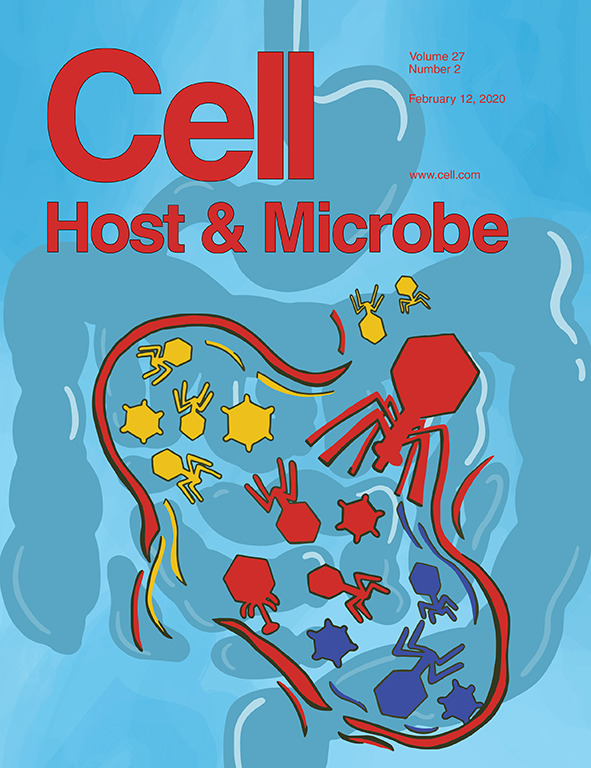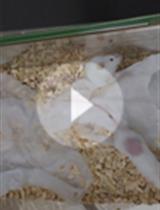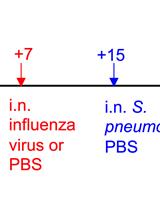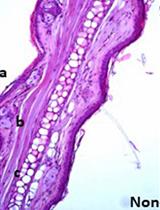- EN - English
- CN - 中文
TetR Regulated in vivo Repression Technology to Identify Conditional Gene Silencing in Genetically Engineerable Bacteria Using Vibrio cholerae Murine Infections as Model System
以小鼠霍乱弧菌感染为模型系统的TetR调控体内抑制技术鉴定基因工程菌的条件基因沉默
(*contributed equally to this work) 发布: 2020年10月05日第10卷第19期 DOI: 10.21769/BioProtoc.3774 浏览次数: 3512
评审: Andrea PuharAnne-Marie Caroline OverstreetAnonymous reviewer(s)
Abstract
Investigation of bacterial gene regulation upon environmental changes is still a challenging task. For example, Vibrio cholerae, a pathogen of the human gastrointestinal tract, faces diverse transient conditions in different compartments upon oral ingestion. Genetic reporter systems have been demonstrated to be extremely powerful tools to unravel gene regulation events in complex conditions, but so far focused mainly on gene induction. Herein, we describe the TetR-controlled recombination-based in vivo expression technology TRIVET, which allows detection of gene silencing events. TRIVET resembles a modified variant of the in vivo expression technology (IVET) as well as recombination-based in vivo expression technology (RIVET), which were used to identify conditional gene induction in several bacteria during host colonization. Like its predecessors, TRIVET is a single cell based reporter system, which allows the analysis of bacterial gene repression in a spatiotemporal manner via phenotypical changes in the resistance profile. Briefly, a promoterless tetR (encoding the transcriptional repressor TetR) can be integrated randomly into the bacterial genome via transposon mutagenesis or site-specific downstream of a promoter of interest via homologous recombination. Reduction of transcriptional expression of TetR results in a de-repression of the TetR-controlled resolvase TnpR, which in turn leads to excision of an antibiotic resistance cassette (also known as res-cassette) and altered resistance profile observable via streaking on ampicillin and kanamycin plates. This alteration can then be quantified as the ratio between resistant and non-resistant isolates. Furthermore, the newly introduced second reporter gene, a promoterless phoA (encoding the alkaline phosphatase PhoA) offers an additional validation step of the results via an independent colorimetric assay to measure enzyme activity. The protocol presented herein also offers an approach to identify the gene locus in case of the random screen for gene repression as well as a quantification of the conditional repression of a gene of interest. Although the current protocol is established for gene repression during host colonization, it can likely be adapted to study gene silencing under various conditions faced by a bacterium.
Keywords: Gene expression (基因表达)Background
Facultative bacterial pathogens constantly need to adapt to varying conditions during environmental passages and host colonization. Optimal survival fitness is assured by transient activation and repression of numerous genes. Unravelling these adaptation processes is key to understand bacterial physiology and identify potential targets for therapeutic intervention strategies. Diverse techniques have been established to study gene expression profiles in bacteria, including microarrays, RNA-Seq and qRT-PCR (Eisen and Brown, 1999; Bookout and Mangelsdorf, 2003; Wang et al., 2009). Such methods have to deal with the consequences of averaging heterogeneity in the bacterial population and only reflect transcription level at the time-point of harvest. Any unique patterns of gene expression related to specific regions in a subpopulation or transient regulation might be lost. Moreover, the requirement of relatively high quantity of RNA and purity restricts the above-mentioned technologies. In contrast, the TRIVET reporter system allows the detection of transient gene silencing events even in a subset of a complex, heterogenous bacterial population. TRIVET is a robust technique due to an irreversible change in the antibiotic resistance profile on a single cell level. On the contrary, TRIVET requires substantial, labor-intensive genetic engineering of the model organism and is therefore limited to bacteria with available genome sequence and tools for genetic modification.
Using the facultative human pathogen Vibrio cholerae as a representative example, we describe two potential applications of TRIVET: (i) a random approach to identify in vivo repressed genes during intestinal colonization in the murine model and (ii) a specific approach to study conditional transcriptional silencing of a gene of interest (Cakar et al., 2018; Zingl et al., 2020). The TRIVET system consists of three chromosomal elements, i.e., a tetR-phoA-cat (tpc) reporter cassette, a suicide vector system pTRIVET providing the TetR-controlled resolvase TnpR and the resolution (res)-cassette as target for TnpR.
The res-cassette of TRIVET is identical to the res-cassette of RIVET (Osorio et al., 2005) and is integrated in the lacZ-locus of the V. cholerae chromosome. The two selection markers [neo(KmR) and sacB (SucS)] are flanked by target sites for the TnpR resolvase also known as the res-sites.
The second part is the tpc-cassette. For the random approach, the tpc-cassette is subcloned between the IS10 sites of the mini Tn10-system using the pLOF vector delivery system (Herrero et al., 1990). Noteworthy, tetR and phoA encoding the TetR repressor and the alkaline phosphatase are promoterless, while the cat cassette was subcloned with its own constitutive promoter to allow selection of transposon mutants. Thus, transposon mutagenesis of res-cassette containing strains following chloramphenicol selection, generates random insertions of the tpc reporter cassette. A sub-population of these transposon mutants harbor transcriptional fusions of chromosomal genes to tetR and phoA and will express these genes upon activation of the respective promoter.
The third component of TRIVET is the pTRIVET suicide plasmid (ApR) containing an 800 bp intergenic region downstream of the lacZ locus and the tnpR (encoding the resolvase). Importantly, the promoter responsible for tnpR expression originates from the tetracycline-resistance gene tetA and is therefore tightly controlled by TetR. Mobilization of this pTRIVET into a res- and tpc-cassette containing V. cholerae strain results in homologous recombination downstream of lacZ in the genome. As the integration site is located downstream of the intrinsic transcriptional terminator of lacZ, undesired read-throughs of the RNA-Polymerase towards tnpR are prevented. Hence, the expression of tnpR solely relies on the TetR-controlled promoter. A comprehensive description of the system including a schematic overview of the genetic elements can be found in a recent publication by Cakar et al. (2019). In strains with tetR expression via the tpc-cassette, repression of tnpR will result in stable res-cassette containing strains, which can be isolated via their unique resistance profile (ApR, KmR and SucS). In contrast, no expression of tetR leads to induction of tnpR resulting in excision and irreversible loss of the res-cassette (ApR, KmS and SucR). This event is called resolution and results in a resolved strain. Thus, a relatively simple KmR-selection will identify strains with sufficient TetR expression with stabilized res-cassette. These strains can be used to infect infant mice. During in vivo colonization, silencing of the chromosomal promoter driving the expression of tetR may occur, which results in an induction of tnpR leading to excision and irreversible loss of the res-cassette. Hence, the loss of the res-cassette during in vivo colonization can be monitored by a phenotypic change to KmS/SucR, allowing the subsequent identification of these resolved strains similar to the original RIVET screens. Besides tetR, phoA acts as an independent transcriptional reporter and provides a refinement of the in vivo resolved strains via an alkaline phosphatase activity assay.
In case of gene specific approach, TRIVET uses the identical res-cassette and pTRIVET elements, while the tpc-cassette needs to be subcloned into the pCVD442 suicide vector flanked by up- and downstream regions of the desired integration site to ensure homologous recombination (Donnenberg and Kaper, 1991). Once the tpc-cassette has been fused to the chromosomal promotor of interest, the res-cassette and the pTRIVET can be subsequently mobilized and integrated into the genome. Such strains harboring a tpc-cassette downstream of a promotor of interest can be used to assay the repression of each fusion under specific conditions (e.g., in vitro and in vivo as described for the yrb-fusion strain). For example, the amount of resolution upon in vitro and in vivo cultivation can be determined by plating appropriate dilutions on LB-Kn (unresolved CFUs) and LB-Ap (total CFUs) plates. The resolved CFUs can be calculated by subtracting total unresolved CFUs from the total CFUs [(ApR CFU) minus (KmR CFU)]. The extent of resolution is given by the resolution frequency (% resolution), calculated as the amount of resolved CFUs divided by total CFUs multiplied by 100. If applicable, phoA acts as an independent transcriptional reporter and allows an additional assessment of the transcriptional activity of the tpc-fusion strain via an alkaline phosphatase assay, which will be described herein for the irgA-fusion strain under iron-replete and iron-deplete conditions.
Although originally designed to identify gene repression during intestinal colonization, TRIVET can be likely adapted to diverse cultivation conditions (Seper et al., 2014; Cakar et al., 2018; List et al., 2018). This technology can thus help to expand our knowledge of bacterial gene regulation, adaptation processes and the regulatory cascades involved.
Materials and Reagents
- Construction of the TRIVET System
- Bacterial strains and plasmids
- Escherichia coli DH5αλpir F− endA1 glnV44 thi-1 recA1 relA1 gyrA96 deoR nupG Φ80dlacZΔM15 Δ(lacZYA-argF)U169 hsdR17(rK− mK+) λpirRK6 (54)
- E. coli XL-1 F′::Tn10 proA + B + lacq Δ(lacZ)M15/recA1 endA1 gyrA46 (Nalr) thi hsdR17 (rK− mK+) supE44 relA1 lac (New England Biolabs)
- E. coli SM10λpirthi-1 thr leu tonA lacY supE recA::RP4-2-Tc::Mu λpirRK6 (Miller and Mekalanos, 1988)
- V. cholerae WT spontaneous streptomycin resistant (SmR) mutant of E7946 (O1 El Tor Inaba), SmR (Miller et al., 1989)
- pCVD442 Suicide vector, OriR6K, sacB, ApR (Donnenberg and Kaper, 1991)
- pA C1000 CmR (Hava et al., 2003)
- pGOA1193 pIVET5n tnpR, oriR6K mobRP4 lacZ tnpR, ApR (Osorio et al., 2005)
- pGP704 oriR6K mobRP4, ApR (Miller and Mekalanos, 1988)
- pTrc99A-Km pBR322 origin, KmR (Amann et al., 1988)
- pRR51 (Reed and Grindley, 1981)
- pSL134 pPCR-Script::(res1-res1) (Osorio et al., 2005)
- pPCR-Script Amp SK(+) (Stratagene)
- pGAO2 [pPCR-Script::(res) (Osorio et al., 2005)]
- pGAO3 [pPCR-Script::(res1) (Osorio et al., 2005)]
- pGAO4 [pPCR-Script::(res-res) (Osorio et al., 2005)]
- pGAO5 [pPCR-Script::(res1-res1) (Osorio et al., 2005)]
- pGAO6 [pGOA4::neo-sacB (Osorio et al., 2005)]
- pGAO7 [pGOA5::neo-sacB (Osorio et al., 2005)]
- pRes pSL111 with res-neo-sacB-res cassette, KmR (Osorio et al., 2005)
- pRes1 pSL111 with res1-neo-sacB-res1 cassette KmR (Osorio et al., 2005)
- pLOFKm Tn10 based delivery plasmid, KmR, ApR (Herrero et al., 1990)
- Escherichia coli DH5αλpir F− endA1 glnV44 thi-1 recA1 relA1 gyrA96 deoR nupG Φ80dlacZΔM15 Δ(lacZYA-argF)U169 hsdR17(rK− mK+) λpirRK6 (54)
- Oligonucleotides
- tetR-5′-BamHIAATGGATCCTAGAGTGTCAACAAAAATTAGGAATTA
- tetR-3′-KpnlTTAGGTACCATCACGGAAAAAGGTTATGCT
- phoA-5′-KpnITTTGGTACCTTTTTAATGTATTTGTACATGGAGAA
- phoA-3′-XbaIAAATCTAGACATTAAGTCTGGTTGCTAACAGCA
- cat-5′-XbaIAAATCTAGATAAGCTTGATGAAAATTTGTTTGA
- cat-3′-BamHITTTGGATCCTTCTTCAACTAACGGGGCA
- tetRphoAcat-5′-NotI TATGCGGCCGCCCTAGGTAATTAGGATCCTAGAGT
- tetRphoAcat-3′-NotI TTTGCGGCCGCCCTAGGTCTCATCCGCCAAAACAGCCAA
- lacZ-5′-SacITTTGAGCTCTGATTTACCGCCGCTGCCAA
- lacZ-3′-NheITTTGCTAGCTTATTGTGGGTGATGACGCTTT
- tnpR-5′-BgIIICGACCCGGGAGATCTCAATTGTTCGAATTTAGGATACATTTTTAT
- tnpR-3′-XbaITTTTCTAGATTAAGTTGGGTAACGCCAGGGT
- PtetA-5′-3′CTAGCCAGAGAGCCTTAAGGCTCTCTTTTTTCTAATTTTTGTTGACACC
CTATCAGTGATAGAGTTATTTTACCACTCCCTATCAGTGATAGA - PtetA-3′-5′GATCTCTATCACTGATAGGGAGTGGTAAAATAACTCTATCACTGATAGG
GTGTCAACAAAAATTAGAAAAAAGAGAGCCTTAAGGCTCTCTGG - Ptet1-5′-3′CTAGCAGAGAGCCTTAAGGCTCTCTTTTTTCTAATTTTTGTCCCTATCA
GTGATAGAGATTGACATCCCTATCAGTGATAGAGATACTGAGCACATCA - Ptet1-3′-5′GATCTGATGTGCTCAGTATCTCTATCACTGATAGGGATGTCAATCTCTAT
CACTGATAGGGACAAAAATTAGAAAAAAGAGAGCCTTAAGGCTCTCTG - 1RES-FTCTATTGAATTCCGTCCGAAATATTATAAATTATCGCAC
- 1RES-RTCTAATCTCGAGTGTATCCTAAATCAAATATCGGACAAG
- 1RES1-FTCTAATGAATTCCGTCCGAAATATTACAAATTATCGCAC
- 2RES-FTCTAATCTCGAGTCTAGACGTCCGAAATATTATAAATTATCGCAC
- 2RES1-FTCTAATCTCGAGTCTAGACGTCCGAAATATTACAAATTATCGCAC
- 2RES-RTCTAATGGTACCTGTATCCTAAATCAAATATCGGACAAG
- T3AATTAACCCTCACTAAAGGG
- T7AATACGACTCACTATAGGGC
- tetR-5′-BamHIAATGGATCCTAGAGTGTCAACAAAAATTAGGAATTA
- Materials
- Pipette tip (Greiner Bio-One, catalog numbers: 740290 , 739290 and 771291)
- PCR tubes (Thermo Fisher Scientific, catalog number: AB0266 )
- Double distilled H2O (ddH2O)
- dNTPs, 10 mM (Thermo Fisher Scientific, catalog number: R0192 )
- DNA Loading Dye (6x) (Thermo Fisher Scientific, catalog number: R0611 )
- Q5 High-Fidelity DNA Polymerase (NEB, catalog number: M0491S )
- Taq DNA polymerase (NEB, catalog number: M0273S )
- GeneRuler 1 kb Plus DNA Ladder (Thermo Fisher Scientific, catalog number: SM1331 )
- QIAquickGel Extraction Kit (QIAGEN, catalog number: 28704 )
- QIAquickPCR Purification Kit (QIAGEN, catalog number: 28104 )
- QIAprep Spin Miniprep Kit (QIAGEN, catalog number: 27104 )
- Cut smart buffer (NEB, catalog number: B7204S )
- Appropriate Restriction Enzymes (NEB)
- Antarctic phosphatase (NEB, catalog number: M0289S )
- T4 DNA ligase (NEB, catalog number: M0202S )
- T4 DNA ligase buffer (NEB, catalog number: B0202S )
- Glycerol (AppliChem, catalog number: A0970 ,1000)
- Yeast extract (Applichem, catalog number: A1552 )
- Bacto Tryptone (Thermo Fisher Scientific, catalog number: 211701 )
- NaCl (VWR, catalog number: 27810.364 )
- Agar (Sigma-Aldrich, catalog number: A5054 )
- Appropriate antibiotic for the plasmid vector (e.g., Ampicillin, Carl Roth, catalog number: K029.2 )
- LB agar plates containing the appropriate antibiotic for the plasmid vector (see Recipes)
- LB medium (see Recipes)
- Pipette tip (Greiner Bio-One, catalog numbers: 740290 , 739290 and 771291)
- Bacterial strains and plasmids
- Construction of the TRIVET library
- Bacterial strains and plasmids
- E. coli DH5αλpir F− endA1 glnV44 thi-1 recA1 relA1 gyrA96 deoR nupG Φ80dlacZΔM15 Δ(lacZYA-argF)U169 hsdR17(rK− mK+) λpirRK6
- E. coli SM10λpir thi-1 thr leu tonA lacY supE recA::RP4-2-Tc::Mu λpirRK6
- V. cholerae WT spontaneous streptomycin resistant (SmR) mutant of E7946 (O1 El Tor Inaba), SmR (Miller et al., 1989)
- pCVD442 Suicide vector, OriR6K, sacB, ApR (Donnenberg and Kaper, 1991)
- pRes pSL111 with res-neo-sacB-res cassette, KmR (Osorio et al., 2005)
- pRes1 pSL111 with res1-neo-sacB-res1 cassette, KmR (Osorio et al., 2005)
- pLOF::tpc (Cakar et al., 2018)
- pTRIVET (Cakar et al., 2018)
- pTRIVET1 (Cakar et al., 2018)
- pRES [pSL111::(res-neo-sacB-res) (Osorio et al., 2005)]
- pRES1 [pSL111::(res1-neo-sacB-res1) (Osorio et al., 2005)]
- E. coli DH5αλpir F− endA1 glnV44 thi-1 recA1 relA1 gyrA96 deoR nupG Φ80dlacZΔM15 Δ(lacZYA-argF)U169 hsdR17(rK− mK+) λpirRK6
- Oligonucleotides
- tetRphoAcat-5′-SacI ATAGAGCTCAGAGTGTCAACAAAAATTAGGAATTAA
- tetRphoAcat-3′-SalI TTTGTCGACTTCTTCAACTAACGGGGCA
- irgA-SphI-1 AATGCATGCTCCGAGTAAACCGCAAACACTT
- irgA-SacI-2 AATGAGCTCGTATCCCGCCGCAGTGACCA
- irgA-SalI-3 AAAAGTCGACCGAACTATTCCATGTGT
- irgA-XbaI-4 AATTCTAGACGTGAGGTTTGGCGCTTA
- yrb_SacI_1AAAGAGCTCGCGATATTGGCAATGTTTGAAC
- yrb_SphI_2AAAGCATGCGATAAGGATAATTAATTGGAATC
- yrb_SalI_3AAAGAATTCTCAGGATGTCGACCTAACAG
- yrb_XbaI_4TTTTCTAGAGATTAAGGTTACGGATCAGTTC
- seqPrimer-catGAATTGTCAGATAGGCCTAATG
- tetRphoAcat-5′-SacI ATAGAGCTCAGAGTGTCAACAAAAATTAGGAATTAA
- Materials
- PCR tubes (Thermo Fisher Scientific, catalog number: AB1771 )
- Needle 26G (B. Braun, catalog number: 4657683 )
- Gavage tubing (Thermo Scientific, catalog number: 10793527 )
- Gavage syringe 1 ml (Henry Schein, catalog number: 9003016 )
- 5-d-old CD-1 mice
- Double distilled H2O (ddH2O)
- dNTPs, 10 mM (Thermo Fisher Scientific, catalog number: R0192 )
- DNA Loading Dye (6x) (Thermo Fisher Scientific, catalog number: R0611 )
- Q5 High-Fidelity DNA Polymerase (NEB, catalog number: M0491S )
- Taq DNA polymerase (NEB, catalog number: M0273S )
- GeneRuler 1 kb Plus DNA Ladder (Thermo Fisher Scientific, catalog number: SM1331 )
- QIAquickGel Extraction Kit (QIAGEN, catalog number: 28704 )
- QIAquickPCR Purification Kit (QIAGEN, catalog number: 28104 )
- QIAprep Spin Miniprep Kit (QIAGEN, catalog number: 27104 )
- QIAprepMidiprep Kit (QIAGEN, catalog number: 12143 )
- Cut smart buffer (NEB, catalog number: B7204S )
- Appropriate Restriction Enzymes (NEB)
- Antarctic phosphatase (NEB, catalog number: M0289S )
- T4 DNA ligase (NEB, catalog number: M0202S )
- T4 DNA ligasebuffer (NEB, catalog number: B0202S )
- Yeast extract (Applichem, catalog number: A1552 )
- NaCl (VWR, catalog number: 27810.364 )
- Bacto Tryptone (Thermo Fisher Scientific, catalog number: 211701 )
- Agar (Sigma-Aldrich, catalog number: A5054 )
- Appropriate antibiotic for the plasmid vector (e.g., Ampicillin, Carl Roth, catalog number: K029.2 )
- Tris (Sigma-Aldrich, catalog number: 10708976001 )
- MgSO4 (Sigma-Aldrich, catalog number: M7506 )
- ZnCl2 (Sigma-Aldrich, catalog number: 746355 )
- SDS (Sigma-Aldrich, catalog number: L3771 )
- Chloroform (Sigma-Aldrich, catalog number: 372978 )
- KH2PO4 (Sigma-Aldrich, catalog number: P0662 )
- p-nitrophenyl phosphate (Sigma-Aldrich, catalog number: 4876 )
- EDTA (Sigma-Aldrich, catalog number: 0 3620 )
- Isoflurane IsoFlo (Zoetis, catalog number: 50019100 )
- Agarose peqGOLD (VWR, catalog number: 732-2789 )
- 50x TAE buffer (Thermo scientific, catalog number: 10399519 )
- 2,2'-bipyridyl (Sigma-Aldrich, catalog number: D216305 )
- FeSO4 (Sigma-Aldrich, catalog number: 450278 )
- X-Gal (5-Bromo-4-chloro-3-indolyl beta-D-galactopyranoside; Thermo scientific, catalog number: R0404 )
- DMSO (Roth, catalog number: 4720 )
- LB agar plates containing the appropriate antibiotic for the plasmid vector (see Recipes)
- LB medium (see Recipes)
- Sucrose agar plates (see Recipes)
- PCR tubes (Thermo Fisher Scientific, catalog number: AB1771 )
- Bacterial strains and plasmids
Equipment
- Pipettes (Eppendorf)
- Combi-vet isoflurane administration instrument (Rothacher, catalog number: CV 30301 )
- Scissors (Thermo scientific, catalog number: 10694962 )
- Tweezers (Thermo scientific, catalog number: 15809651 )
- Tissue homogenizer (Biospec, catalog number: 985370 )
- Vortexer (Thermo Fisher Scientific)
- Incubator (Thermo Fisher Scientific, ThermoScientificTM, model: Heraeus B12 Function Line, catalog number: 50042307)
- Microcentrifuge (Eppendorf, model: CentrifugeMiniSpin®, catalog number: 5452000018 )
- Thermocycler (Bio-Rad C1000 )
- NanoDropTM ( ND 2000 )
- Photometer (Beckman DU730 )
Software
- blastN (blast.jcvi.org/cmr-blast/)
- Tm Calculator Software (e.g., NEB Tm Calculator)
Procedure
文章信息
版权信息
© 2020 The Authors; exclusive licensee Bio-protocol LLC.
如何引用
Zingl, F. G., Mitterer, F., Thapa, H. B. and Schild, S. (2020). TetR Regulated in vivo Repression Technology to Identify Conditional Gene Silencing in Genetically Engineerable Bacteria Using Vibrio cholerae Murine Infections as Model System. Bio-protocol 10(19): e3774. DOI: 10.21769/BioProtoc.3774.
分类
微生物学 > 微生物-宿主相互作用 > 体内实验模型 > 哺乳动物
微生物学 > 微生物遗传学 > 基因表达
分子生物学 > DNA > 基因表达
您对这篇实验方法有问题吗?
在此处发布您的问题,我们将邀请本文作者来回答。同时,我们会将您的问题发布到Bio-protocol Exchange,以便寻求社区成员的帮助。
提问指南
+ 问题描述
写下详细的问题描述,包括所有有助于他人回答您问题的信息(例如实验过程、条件和相关图像等)。
Share
Bluesky
X
Copy link












